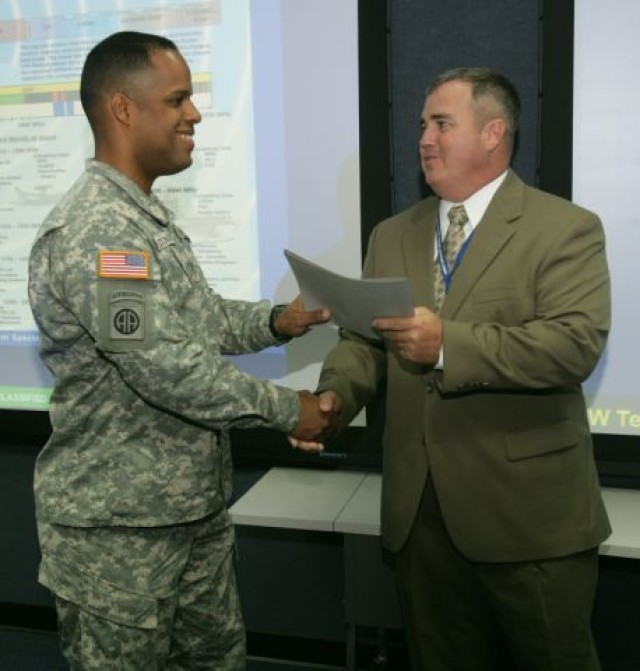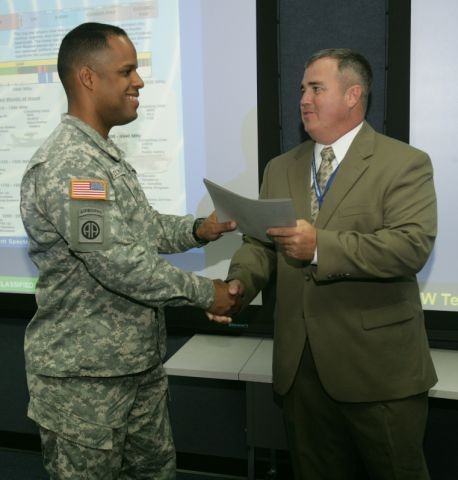
FORT SILL, Okla. (Army News Service, July 20, 2009) -- Eight warrant officers graduated July 17, from a 16-week Electronic Warfare Technician Course at Fort Sill and several will serve as the ArmyAca,!a,,cs first EW warrants in Iraq.
Until this year, the Army relied on the Navy to provide EW officers in Iraq.
Army leaders saw a problem with that system, so in 2006 the Army began to prepare to train its own EW specialists. Now, Fort Sill finds itself on the cutting edge of Army electronic warfare offering classes to officers, NCOs and warrant officers.
Warrant Officer Luis Maldonado, one of the graduates, was an Army aviator who volunteered to tackle the new electronic warfare specialty.
Maldonado will now go on to Fort Hood, Texas, where he'll become the EW warrant for the 4th Brigade of 1st Cavalry Division for their upcoming deployment.
"Our specialty is synchronizing and coordinating electronic warfare while we advise the commander on how to use those assets, not only to attack the enemy, but also how we can protect our forces from an enemy that has their own capabilities," Maldonado explained.
The training included the latest and greatest technology the military had to offer, according to the course manager, because these warrants are leaving here to go to the tip of the spear.
"All of these warrants are being assigned to brigades about to deploy," said Sam Houston, course manager. Houston, a contract employee from Northrop Grumman and retired field artillery officer, explained that the Army will be adding EW Soldiers to every unit from battery or company to the highest headquarters.
At the lowest levels, the Soldiers will be enlisted technicians to operate and maintain vehicle-mounted equipment for detecting roadside threats. Battalions will have an EW noncommissioned officer and higher headquarters will have an EW team with a mix of NCOs, warrant officers and officers, Houston said.
Maldonado said this group of warrants doesn't have authorized positions in those headquarters yet. He said the EW slots won't be added to unit headquarters until next year. But several of the warrants are being assigned against the new MTOE anyway, another Army official said.
Warrant Officer Jason Mounce hails from Bella Vista, Ark., and is the EW warrant for Headquarters Battery, 1st Battalion, 142nd Fires Battalion of the Arkansas National Guard.
For Mounce, it was training he couldn't resist.
"This was too good an opportunity to pass up," Mounce said with a smile. "I saw the announcement on Army Knowledge Online. It's a new field and I'm one of eight people in that field, and I like what EW is about. I'd be crazy to pass it up."
Mounce started the journey in February as a Fire Direction Center chief. He first graduated from the Warrant Officer Basic Course at Fort Rucker, Ala., before reporting to Fort Sill for the 16-week course.
"I feel confident that I could go out to the field and execute my mission with what I've learned in this course," Mounce said.
"You might say this is the final frontier as far as battle is concerned," Mounce said. "You're talking about computer networks, electronic communications, and no matter what military you are, those are things that you're depending upon. Even at the lowest level, you need a way to talk to your troops."
Because EW warrant officers will be advising at brigade and higher headquarters, the Army gave them a wide range of knowledge. Houston said Northrop Grumman, the company contracted for the training, brought in a wide range of experts to help design this specific course.
"It's a combination of not only the EW portion that Northrop Grumman teaches here, but courses taught at other services and the Joint EW Course out of San Antonio," Houston said. All the armed forces input to the training plan.
This first course, also known as Pilot Course One, was designed for eight students. The next course will be bigger and the third course, Pilot Course Three, will find the course in its final, custom-built home at Burleson Hall with 25 students.
Burleson Hall, home of EW, will provide a variety of secure class rooms, according to Houston. In addition to computer-packed modern classrooms there will be large areas to pull in equipment for training or to conduct simulated field training exercises.
Houston expects the course to change once all 4,000 projected EW slots are filled.
"This is a transition course that teaches both basic and advanced skills because we have from WO1 to CW3," Houston said. "In time, it will evolve into a basic course and an advanced course. The advanced course will train warrants to work at division and higher headquarters and joint positions. We've got to start somewhere.''
Chief Warrant Officer Santa Mediavilla, a Brooklyn, N.Y. native, leaves the course to report to the 1st Brigade Combat Team, 3rd Infantry Division, at Fort Stewart, Ga., for her third combat deployment. She's looking forward to fulfilling a personal drive -- she's just been reclassified from a Long Bow Apache pilot and looks forward to her EW mission.
"I'm going from protecting the ground forces in the air to protecting the ground forces on the ground - works for me!" Mediavilla exclaimed.

Social Sharing